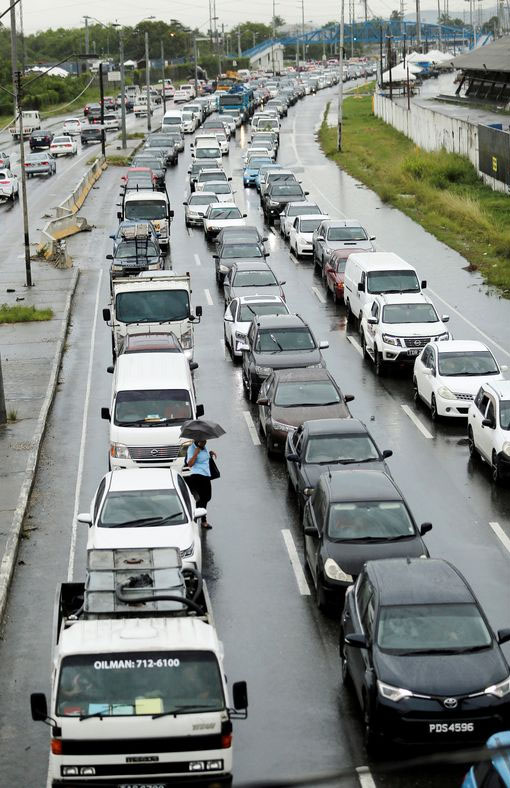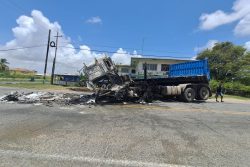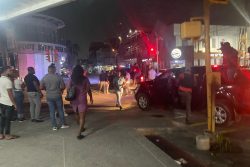(Trinidad Guardian) Vehicle traffic congestion imposes a direct economic burden of roughly 1.37 per cent of annual GDP on T&T.
This measure represents a lower bound estimate of economic costs, given that it does not include other social and environmental costs typically associated with the phenomenon, according to an assessment published this month by the Economic Commission for Latin America and the Caribbean (UNECLAC) titled, “Assessment of the economic costs of vehicle traffic congestion in the Caribbean: a case study of T&T.”
Authored by Willard Phillips, Elizabeth Thorne and Esther Chong Ling, the 51-page document also noted that traffic challenges are also likely to have important public policy implications for this country, as it seeks to implement strategies for mitigating the problem in the future.
The study findings explained that after three months, 264 respondents completed the online survey, yielding a response rate of 52.8 per cent.
Fifty-six per cent of respondents were female with the remainder being male.
The majority (83 per cent) commuted at least three times per week and did so by self-driven private vehicle (81 per cent).
It also noted that considering commuting expenses, respondents spent an average of $1,037 every month on fuel/bus or taxi fares.
Further, according to its analysis, the study explained, “Given the weekly average time lost from the survey, total annual time lost per worker for T&T was estimated at 793 hours. This approximates to 16 hours per worker for each work week.
“Using hourly wage rates partitioned across the total labour participation rate for 2021, the direct economic cost for traffic congestion in T&T was estimated at $2.26 billion for 2021 or roughly 1.37 per cent of annual. From the analysis, it is apparent that time lost to professionals and technicians, results in the highest economic burden due to traffic congestion in the economy.”
The survey also detailed spatial impacts.
It noted that commuters reported an average of two locations where they faced significant traffic congestion in their daily commute.
It explained that consistent with the distribution of population and the evolved transportation network, the most intense traffic congestion was experienced in the more densely populated areas of the country.
“Taking a regional perspective, transit routes along the main north-south highway (Uriah Butler Highway), and the main roadways of the East-West corridor (Churchill Roosevelt Highway, Eastern Main Road, Audrey Jeffers Highway and Western Main Road) endure the brunt of the traffic congestion on the island of Trinidad.
“A significant level of congestion also occurs along the main arterial roadways of the southwest peninsula which connect to the southern industrial city of San Fernando. Among the specifically recognised, intensely congested transit routes are Chaguanas to Port of Spain; Chaguanas to Couva; Arima to Port-of-Spain; Port-of-Spain to Diego Martin; and San Fernando to Point Fortin.
“Less intense, but equally significant traffic congestion, also occurs in regional towns and municipalities such as Sangre Grande in the North-East; and Penal; Siparia; Debe, and Princes Town in the South-Central regions of Trinidad,” the study further explained.
In the case of Tobago, the study noted that while traffic congestion is comparatively less compared to Trinidad, most traffic congestion is experienced in the South-West of the island along Milford Road, and the connecting Claude Noel Highway.
“These two roadways form the main arterial connection of the more densely populated southwest, with the island’s capital at Scarborough. Additional traffic congestion is also routinely observed on main suburb connecting routes such as Scarborough to Calder Hall, and Scarborough to Mount Marie,” the assessment stated.
The study detailed that several seasonal events impact on traffic congestion in T&T, citing that among them, the rainy season and Christmas holidays generate increases in annual per capita traffic delays of 9.3 and 8.9 hours respectively, while the annual school closures reduce traffic delays by roughly 7.7 hours annually.
Also, it noted that the annual Carnival season (5.0 hours), as well as month ends (5.6 hours) also significantly increase traffic congestion during the year.
Averting behaviour and other costs
According to the survey, in the face of enduring traffic congestion, commuters typically adopt coping strategies to mitigate impacts.
Such averting behaviour, it said, may result in additional expenditure such as food, supervisory care for children, communications, or after-work activities.
In the case of T&T, survey respondents reported an average monthly additional costs of $558 to meet such expenses.
This amounts to an additional annual expense of $6,696 per capita and represents a further economic burden of traffic congestion in the country.
Policy implications and conclusions
In its concluding chapter, the assessment stated that the most important policy implication which arouse from the study’s findings was the level of public sector investment that would likely be necessary to mitigate the vehicle traffic congestion challenge in T&T.
“An opportunity cost, measured in this instance as a direct economic burden of 1.37 per cent of annual GDP is not trivial, and represents a considerable economic benefit that the country routinely foregoes each year because of vehicle traffic congestion.
“This is brought into sharper relief if it is considered that the estimate closely approaches the GDP contribution (current prices) of the agriculture, forestry and fishing subsector (1.5 per cent), and is 12 per cent of the GDP contribution for the petroleum and chemical products subsector (11 per cent) in 2021 (CSO, 2023). Moreover, in the context of the prevailing dynamics discussed above, it is reasonable to expect that these costs would continue to increase over the medium to long term,” it said.
The assessment suggested that policy options for consideration over the short to medium term include:
* The continuing efforts to strengthen public transportation services, including strategies to make public transportation services more accessible and attractive to commuters. In this regard, it advised that an examination of the prospects for enhancing the role of para-transit service providers; initiatives to enhance first and last mile transportation options; and efforts to improve public safety of both commuters and service providers are critical;
• Wider adoption of telecommuting as an option to reduce the need for physical commuting especially among the professional categories of workers for whom this may be feasible;
• Further investment in a school bus service which could mitigate the school-generated traffic congestion associated with the daily parental delivery and pick-up of school children;
• Application of better spatial planning and traffic management tools when planning for annual and/or seasonal events.
Further, the assessment added that the principal long run strategy of implementation of an efficient, reliable, and multi-modal public transportation system, along with decentralisation of public services remains key to solving the vehicle traffic congestion problem in T&T.
“Such a strategy should be seen to be moving persons off the physical roadway, and onto the digital highway. In this regard, digitally supported analytics for scheduling, tariffing, fleet maintenance, and intermodal connectivity are critical,” the study added.
Finally, it emphasised that efforts to enhance public safety and security would be central to supporting and encouraging the widespread use of public transportation that would be a key requirement for alleviating the vehicle traffic congestion problem.










